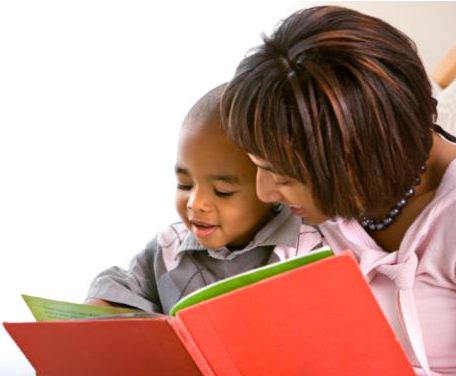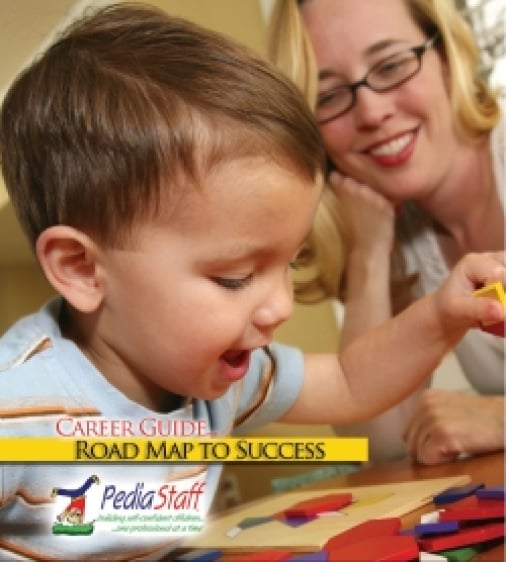SLP Corner: How to Use Books to Improve Toddlers’ Communication Skills

by Kimberly Scanlon, M.A. CCC-SLP
As a pediatric speech language pathologist who specializes in treating toddlers and preschoolers, I often use books during my speech therapy sessions. In fact, I LOVE using books as a way to get toddlers to open up and chitchat! In this article, I’m going to share some tips that have been successful for me in getting toddlers to talk while “reading” books.
Research tells us that it’s never too early to start reading to children. Although, I’m sure a few of us have known a toddler or two who just aren’t into books. They would much rather play with trucks than sit around and read picture books. So, what should you do? Should you force the child to sit down and read books? Probably not. But, before casting the books aside too quickly, try the following:
- Let the child pick the book. Sometimes it’s that simple. I love to give my clients choices during sessions. Pre-select two or three books related to his interests and let him choose from the selection. If Johnny likes to play with trains, then read a book about trains (e.g. Freight Train by Donald Crews is a personal favorite of mine).
- Opt for moveable books. There is some evidence to suggest that children with delays talk more when they are engaged with books that can be manipulated (e.g. tabs to pull, flaps to lift). So, try seeing if the toddler likes books that can move and be easily pulled, lifted, and turned.
- Incorporate props. If your client struggles to stay focused when reading, bring in props that can complement the story (i.e. plastic food and a stuffed caterpillar for reading The Very Hungry Caterpillar by Eric Carle). Many children learn by doing and need something to occupy their hands and bodies; using props or puppets may help.
- Use as a transitional activity. Read a book about food before eating lunch (I like Leslie Patricelli’s Yummy Yucky) or read a book related to winter before making a snowman with cotton balls (e.g. Snowballs by Lois Ehlert). Use anticipatory phrases like “We’re going to read _____ then ______ (eat, play, sing, etc.). This way the child knows what to expect when finished reading.
- Minimize background noise. A noisy environment can hamper a child’s ability to acquire vocabulary and learn new words. Not only does noise make it difficult to adequately perceive speech (“Did, Suzy say cat or bat”) but it can also negatively affect the encoding and storage of new words. This is because the brain works so hard filtering out the noise that it spends less time focusing on and processing the new content.
- Time it right. Read books when your client is not over-stimulated, tired, cranky or hungry. He should be relaxed and ready to enjoy the reading experience. Studies indicate that when book reading lasts longer than five minutes and more than one book is read, the learning effects are enhanced. If the toddler becomes restless before 5 minutes then try a different book or move on to something else.
So, let’s get on with the tips!
1. Relate the book to the child’s own experiences
Children love when they can relate to the characters in a story, so point out the connection. If reading It’s Time to Sleep, My Love by Nancy Tillman, talk about his favorite stuffed animal or how he saw a giraffe at the zoo. Or, read books related to what’s going on in their lives now. For instance, if you are trying to potty train your child, then read a book about potty training.
2. Comment on the story
One simple way to get a young child to open up and express himself during book reading is to say something about what you are thinking. For instance, in Sandra Boynton’s book Oh My Oh My Oh Dinosaurs!, instead of saying “What is this?” or “What is that?” try saying something about the pictures, “Wow, those dinosaurs made a mess!” Most children will usually respond or react to comments by laughing, looking at you, gesturing or even saying something.
3. Give praise
Obvious, right? It may be, but let me point out two things:
- Make sure it’s not ALWAYS overly effusive. Sometimes when you give praise that is too over the top it can lose its effect and be distracting. Of course, if you are naturally bubbly (like moi) it can be hard to lessen this tendency. But, as I’ve learned not all children like it when you are overly bubbly. So, if your client blurted out a word that you’ve never heard instead of dancing around the room, give him a big smile and…see the next bullet point.
- Give target specific feedback. Don’t just say “Good job” or “Nice talking” Be specific. Tell the child exactly what you liked (e.g. “That’s right, you said _______! I really liked how you said _____”). This way he knows why you are so pleased with his performance.
4. Pause
Incorporate pauses so the toddler has time to scan the details in the picture. After you finish reading a sentence or two, periodically pause for a few seconds (count of 3 to 5 Mississippi) and look invitingly as if waiting for a response or turn in a conversation. Usually, he will say something!
5. Imitate the child
Oh, do children LOVE when you imitate what they say. So, if he says “Boo!” You should say “boo” too. This reinforces what he said and lets him know that speaking is social and fun. This technique works best with children who are not yet talking or only talking a little.
6. Expand on it
Expand it by adding in the missing words. This technique works best with children who are using two or three word combinations but may be missing some words. For instance, the child says “baby cry” or “doggie bark”. Then say, “The baby is crying” or “The doggie is barking”. As you can see, you are adding in words to form a grammatically correct sentence.
7. Read with enthusiasm
This one is pretty obvious, no? When you use inflection to stress certain words and are animated children better attend to these words which help with encoding and recall.
8. Fill in the blank
When it comes to young children, I’m a big proponent of stories that have repetitive lines in them. When a phrase or sentence repeats itself children can much more easily remember the words and say some on their own. So, after your child has become familiar with a particular book, start to leave a word out and look invitingly at him or her to fill in the blank. For instance, if reading “Brown Bear, Brown Bear, What do you See?” by Eric Carle say “Brown Bear, Brown Bear, What do you ____ (pause and look at the child with a raised eyebrow or expression to elicit the response from him or her). If he needs further assistance point to your eyes and or give the first sound of the word (e.g. “s” as in see).
9. Question Use.
Use questions to encourage back and forth communication. Don’t use questions to test knowledge. Too many times, we ask too many questions and are in constant test mode. Gauge the types of questions based on the child’s level of development. If he’s struggling to talk, start by asking him to point to pictures. If he has just begun talking, ask questions that require one or two word responses (what, who, and where). If he’s a real chatterbox, then ask questions that require more complex answers like, “What do you think will happen next?” or “Why do you think the boy is sad?” Reminder – when you ask a question make sure you give him time to process and think about his answer (that’s where those Mississippis come in!)
10. And last but not least
RELAX and HAVE FUN!
I hope these tips have been helpful. My biggest take-away is to remember that the quality of the interaction is the most important factor. As the treating clinician, you know your client best, so implement these tips in your own unique way.
References:
Hoggan, K.C., &Strong, C.J.(1994). The Magic of “Once Upon a Time”: Narrative Teaching Strategies. Language, Speech, and Hearing Services in Schools, 25, 76-89.
Kaderavek, J.N., & Sulzby, E.(1998). Parent-Child Joint Book Reading: An Observational Protocol for Young Children. American Journal of Speech Language Pathology, 7(1), 33-47.
Kaderavek, J.,& Justice, L.(2002). Shared Storybook Reading as an Intervention Context: Practices and Potential Pitfalls. American Journal of Speech Language Pathology, 11, 395-406.
Trivette, C.M., Dunst, C.J., & Gorman, E. (2010). Effects of Parent-Mediated Joint Book Reading on the Early Language Development of Toddlers and Preschoolers. CELLReviews, 3(2), 1-15.
Featured Contributor: Kimberly Scanlon, M.A. CCC-SLP,
Kimberly Scanlon, M.A. CCC-SLP, is a speech language pathologist practicing in Bergen County, NJ. She provides home based speech therapy for children and adults through her private practice Scanlon Speech Therapy, LLC. Recently, she published her first book, My Toddler Talks: Strategies and Activities to Promote Your Child’s Language Development. To learn more, please visit www.scanlonspeech.com.
PediaStaff is Hiring!
All JobsPediaStaff hires pediatric and school-based professionals nationwide for contract assignments of 2 to 12 months. We also help clinics, hospitals, schools, and home health agencies to find and hire these professionals directly. We work with Speech-Language Pathologists, Occupational and Physical Therapists, School Psychologists, and others in pediatric therapy and education.
